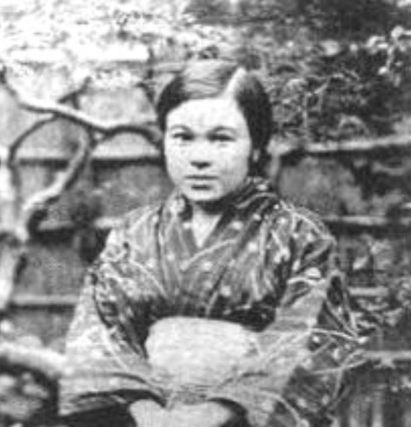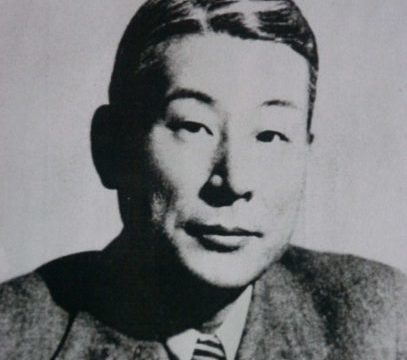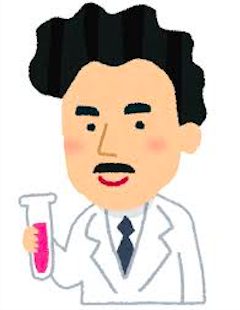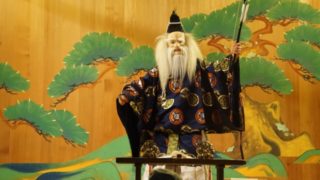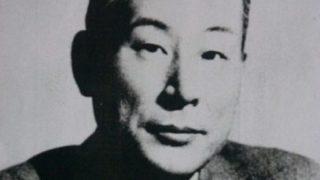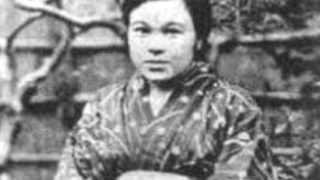Yukie Chiri(知里幸恵) is a well-known woman in Hokkaido, but not in other parts in Japan. Even I didn’t know her. However, when I learned about her, I was so excited and really into her.
Since “Westernization” was considered as rational, under the policies of “rich country, strong army” and “industrial development” during the Meiji period, old, small and different things were the targets to be eliminated. Under these circumstances she lived desperately for 19 years until the end of her days. You can see her beauty through her short lifetime. This is a chance to explore the interesting Ainu culture since her story is strongly connected with Ainu. Extremely fascinating and distinctive design, song and dance are all impressive aspects of Ainu culture. Let’s explore the different aspects used in Ainu literature to show who they are as a people.
Understanding “difference” and admitting “difference” ,is something we shouldn’t forget. The majority of Japanese people consider Japan a racially homogeneous nation, but it’s not true. After the assimilation policy between Yamato(main land) and the Ainu people progressed, the distinctive language, culture and custom of Ainu still remained.
The history from the fact. Tyranny of the majority for thousands years, and the history of twists and turns regardless of its offenders and sufferers, reflect the beauty and ugliness of human beings.
Contents
- 1 The lifetime and personality of Yukie Chiri
- 1.1 A smart girl who was born in Meiji period
- 1.2 The encounter with the professor, Kyosuke Kindaichi changed her life
- 1.3 She moved up to Tokyo despite having a fatal disease A wish which was invested in the young girl
- 1.4 Her personality, the history of Ainu and the Meiji restoration
- 1.5 The Ainu literature “Where the Silver droplets fall…”, which was passed down by Yukie Chiri
- 2 The future of Ainu after her death
The lifetime and personality of Yukie Chiri
Yukie Chiri might not be known well in most of the parts in Japan, but is well-known in Hokkaido. I will write her background first.
A smart girl who was born in Meiji period
She was an Ainu girl who ended her days at the age of 19. She was born in Horobetsu-Gun, Hokkaido, as the first daughter in her family in 1903. Her father, Takayoshi and her mother, Nami were from Ainu. In her childhood, they were barely making a living because her father killed someone in a gun shooting accident and they needed to take care of the victim’s family. Since she was naturally smart, her grandmother, Monasinouku encouraged her to go to a vocational school. Monasinouku was a so-called shrine maiden of Ainu, who was a singer of Yukara; the singer is called Yukarakuru. Yukie’s record in her school was really great, and she spoke fluent Japanese. However, she was always harassed by the students who felt uncomfortable about her brightness and her background of Ainu. She spent her school life enduring the situation.
The encounter with the professor, Kyosuke Kindaichi changed her life
During these circumstances, the professor, Kyosuke Kindaichi ,who was known as a prominent linguist, visited Asahikawa. He had a great interest in the language, culture and customs of Ainu, which lead him to visit her as soon as he heard the rumor of her genius. They hit it off together at the first meeting. Yukie showed him many pieces of Kamuiyukara(traditional god music of Ainu), which were passed down by her parents. At that time, 50 years had already passed since the Meiji restoration, so there were few people who spoke Ainu language well even if they were elderly. Kyosuke was fascinated the beautiful melody at once, and he believed her to be the successor of the precious Ainu tradition. She was also impressed with his enthusiasm that he was willing to write all Ainu tradition down without missing even a single word, and she felt that the things she had believed would come true.
She moved up to Tokyo despite having a fatal disease
A wish which was invested in the young girl
Kyosuke encouraged her to come to Tokyo as a research collaborator, but her grandmother was against it. There was also a man she had feelings for, so she couldn’t make up her mind to go to Tokyo easily. Before long, she found out she had a fatal disease, tuberculosis, and the condition of the disease was critical and couldn’t be helped. So she decided to go to Tokyo alone after saying “good bye” to the man.
She stayed at Kyosuke’s home in Tokyo, but her disease had got worse, and the relationship with Kyosuke’s family was not well enough. Nevertheless she devoted the rest of her life to passing down the Ainu culture which she believed in. She eventually passed away at the age of 19.
Her personality, the history of Ainu and the Meiji restoration
First of all, we need to know the history of Ainu in order to understand her personality. The indigenous people who had inhabited Japan since before the Jomon period(14,000–300 BCE), were mixed with the people who had immigrated from continental Asia to Japan. Some of the indigenous people were alienated from main land into northern and southern parts. It is often said that Ainu and Okinawa people are very similar in terms of their DNA.
The indigenous people who were called “Ezo”, were gradually alienated into northern parts of Japan by being put under pressure from Yamato regime. After that, they were mixed with Okhotsk people who immigrated from the Northern continent and so a distinctive culture was generated. Finally, they faced the Meiji restoration. Although Ainu people in Hokkaido were even exploited severely during Edo period, many people immigrated from main land after Meiji restoration, and so Ainu people were deprived their habitation, so that they had been oppressed physically and mentally. They were seen as barbarians, targets of discrimination, and were forced to speak Japanese. Ainu culture declined rapidly in this circumstance, and Yukie Chiri was born in this period.
The Ainu literature “Where the Silver droplets fall…”, which was passed down by Yukie Chiri
This is the most famous piece of Ainu music, and its well-refined literary talent is admired.
“Shirokanipe ranran pishkan, konkaniperanran pishkan.” arian rekpo chiki kanepetesoro sapash aine, ainukotan enkashike chikush kor shichorpokun inkarash ko
Going down along the stream with singing “Where the silver droplets fall, where the golden droplets fall”, and looking down on, while going through the upper part of human village…… (to be continued)
There are also other oral literature, such as “The god of hero, Ponyaunpe”, leaving people impressed with these pieces to this day. These pieces tell us their respect for northern nature and remind us that Yamato people naturally had these kinds of things in the past.
They also had a distinctive ritual called “Kuma Okuri(Ainu brown bear sacrificial ceremony).” Brown bear was considered as a god on the ground in Ainu, so they killed it, sang and danced; shared its meat together, and used its fur for their cloths and sofa. After that they returned it to the “pure clean river.” This might seem a little savage, but we also could feel human’s vigor.
The future of Ainu after her death
After she passed away, Kyosuke finished writing his research, named “Research of Yukara, Ainu epics.” This became a foundation of Ainu research. Since Yuie’s younger brother, Mashiho was also a smart person, he supported Kyosuke’s research, but before long, he left Kyosuke due to the gap of their policy. After that, Mashiho became the first professor of the Ainu people in Hokkaido University, and he researched and refined Ainu on his own.
After that, the assimilation between Ainu and Yamato people has been progressing through the periods of WWⅡ and high economic growth. Through the experience, we are looking for how we can take care of Ainu culture and pass it down to future generations.
Modern Japanese people tend to consider that Japan is a racially homogeneous nation, but most of us overlooked the truth. For example, thinking about the Northern Territories issue, Yamato and Russian people started to immigrate there around one hundred years ago, but in fact, Ainu people had inhabited there since hundreds or thousands years ago, while respecting nature; wind, forest, ground and water.
Sometimes, “Common sense” might be wrong.
We need to explore.
We need to look closer at the thing that Yamato, Ainu, Kyosuke, Mashiho and Yukie pursued.
Next, I will post an article with Japanese together for those who want to learn Japanese.
知里幸恵の生涯と人柄。アイヌ文学伝承の功労者は大いなる時代の逆流にあってなお何を残す
The lifetime and personality of Yukie Chiri – meritorious person for oral tradition of Ainu literature.
知里幸恵(ちり ゆきえ)は北海道では比較的よく知られている女性だが、本州以南ではなかなかそうはいかないだろう。
Yukie Chiri(知里幸恵) is a well-known woman in Hokkaido, but not in other parts in Japan.
かくある私もそうだった。
Even I didn’t know her.
が、初めてその存在を知ったその時から、私の心は躍動し、釘付けとなった。
However, when I learned about her, I was so excited and really into her.
時代は明治、「富国強兵」「殖産興業」の名のもとに「西洋化」することが合理化とされ、古きもの、小さきもの、異質なるものは、斬り捨てられる対象でしかならなかった。
Since “Westernization” was considered as rational, under the policies of “rich country, strong army” and “industrial development” during the Meiji period, old, small and different things were the targets to be eliminated.
そんな中にあって、知里幸恵の、絞り出すように生き抜いた19年のあまりに短い生涯。
だが、その刹那に見る美しさ。
Under these circumstances she lived desperately for 19 years until the end of her days. You can see her beauty through her short lifetime.
どうしてもこの人と共に説明しなければならないのはアイヌのことである。これを契機にアイヌの文化を探求してみると面白い。
This is a chance to explore the interesting Ainu culture since her story is strongly connected with Ainu.
あまりに素晴らしい独特のデザイン、謡い、舞踊、どれを取ってもわれらの心に迫るものである。
Extremely fascinating and distinctive design, song and dance are all impressive aspects of Ainu culture.
そして、見てほしい。彼女らが伝えようとした「アイヌ文学」を。
Let’s explore the different aspects used in Ainu literature to show who they are as a people.
「違い」を知る、「違い」を認める。我々が失ってはならないものがそこにはある。
Understanding “difference” and admitting “difference” ,is something we shouldn’t forget.
日本人の多くの人が当たり前に「単一民族国家」として日ごろ生活しているが、そうではない。
The majority of Japanese people consider Japan a racially homogeneous nation, but it’s not true.
大和人との同化がかなり進んだとはいえ、アイヌ独特の言葉と文化と暮らしが息づいていた。
After the assimilation policy between Yamato(main land) and the Ainu people progressed, the distinctive language, culture and custom of Ainu still remained.
そこに知る「歴史」。
The history from the fact.
数千年単位での多数者による圧迫。加害者被害者を越えた歴史のうねりというもの。
人の美醜というものを直視させる。
Tyranny of the majority for thousands years, and the history of twists and turns regardless of its offenders and sufferers, reflect the beauty and ugliness of human beings.
———————————————————————–
もくじ
Contents
知里幸恵の生涯、人柄
The lifetime and personality of Yukie Chiri
明治に生まれたあるアイヌの利発な少女
A smart girl who was born in Meiji period
金田一京介教授とのめぐり逢いが少女知里幸恵を変えた。
The encounter with the professor, Kyosuke Kindaichi changed her life
死病にあって、すべてをなげうち帝都へ。その若すぎる身に託された思い
She moved up to Tokyo despite having a fatal disease
A wish which was invested in the young girl
アイヌの歴史と「維新」と、知里幸恵の人柄
Her personality, the history of Ainu and the Meiji restoration
知里幸恵が語り継いだアイヌ文学「銀のしずく降る降る…」
The Ainu literature “Where the silver droplets fall…”, which was passed down by Yukie Chiri
知里幸恵の死後。アイヌと新たなる歴史の風
The future of Ainu after her death
———————————————————————–
知里幸恵の生涯、人柄
The lifetime and personality of Yukie Chiri
知里幸恵は、本州以南に居住する方には今一つ馴染みのない名かもしれない。が、北海道ではよく親しまれている。まずは知里幸恵の生い立ちから書いていきたい。
Yukie Chiri might not be known well in most of the parts in Japan, but is well-known in Hokkaido. I will write her background first.
明治に生まれたあるアイヌの利発な少女
A smart girl who was born in Meiji period
知里幸恵は、19歳で生涯を終えたアイヌの少女。1903年(明治36年)アイヌの父高吉母ナミの長女として北海道幌別群に生まれる。幼いころ、父が銃で人を誤殺してしまい、その遺族の世話などもあって家計は苦しかった。ただ、生来の利発さもあって、旭川に住む祖母モナシノウクに招かれ、そこから実業学校に通う。
She was an Ainu girl who ended her days at the age of 19. She was born in Horobetsu-Gun, Hokkaido, as the first daughter in her family in 1903. Her father, Takayoshi and her mother, Nami were from Ainu. In her childhood, they were barely making a living because her father killed someone in a gun shooting accident and they needed to take care of the victim’s family. Since she was naturally smart, her grandmother, Monasinouku encouraged her to go to a vocational school.
元来、モナシノウクはユーカラクルと言われるユーカラの謡い手、いわばアイヌの巫女のような女性であった。
Monasinouku was a so-called shrine maiden of Ainu, who was a singer of Yukara; the singer is called Yukarakuru.
幸恵の成績は入校後も極めて優秀、「日本語」も堪能。ただ、生まれがアイヌであったことから同級生たちの嫉妬心を焚き付け、種々の嫌がらせを日常的に受け、それをどうにか静かに耐えながら学生生活を過ごす。
Yukie’s record in her school was really great, and she spoke fluent Japanese. However, she was always harassed by the students who felt uncomfortable about her brightness and her background of Ainu. She spent her school life enduring the situation.
金田一京介教授とのめぐり逢いが少女知里幸恵を変えた。
The encounter with the professor, Kyosuke Kindaichi changed her life
そんな最中に旭川を訪れていたのが後に言語学の大家と知られる金田一京介教授。
During these circumstances, the professor, Kyosuke Kindaichi ,who was known as a prominent linguist, visited Asahikawa.
京介はアイヌの言語、文化、習俗に強い関心を寄せており、「天才少女」の噂を聞き知って、このモナシノウクの家を訪ねた。
He had a great interest in the language, culture and customs of Ainu, which lead him to visit her as soon as he heard the rumor of her genius.
たちまち二人は意気投合。
They hit it off together at the first meeting.
幸恵は幼いころから父母や祖母らから口述で学んだ『カムイユカラ(アイヌの伝統的な神謡)』を続々と披露。
Yukie showed him many pieces of Kamuiyukara(traditional god music of Ainu), which were passed down by her parents.
当時すでに維新以来早約50年の時の経過、アイヌであってもよほどの年長者でなければその言葉を手繰ることもできない。
At that time, 50 years had already passed since the Meiji restoration, so there were few people who spoke Ainu language well even if they were elderly.
京介はたちまちその美しい旋律に惹かれ、彼女を類稀なるその伝統の継承者として惚れこむ。
Kyosuke was fascinated the beautiful melody at once, and he believed her to be the successor of the precious Ainu tradition.
そして幸恵もどこまでも真剣に一語一語を漏らさず書き留めんとするその男の様に甚く感銘を受け、また自分の信じてきたものは確信となり希望となる。
She was also impressed with his enthusiasm that he was willing to write all Ainu tradition down without missing even a single word, and she felt that the things she had believed would come true.
死病にあって、すべてをなげうち帝都へ。その若すぎる身に託された思い
She moved up to Tokyo despite having a fatal disease
A wish which was invested in the young girl
京介に激賞された幸恵は共同研究者として「東京」への誘いを受けるが、祖母らの反対や当時思いを抱いていたあるアイヌの一青年のこともあって上京への踏ん切りをなかなかつけられずにいた。
Kyosuke encouraged her to come to Tokyo as a research collaborator, but her grandmother was against it. There was also a man she had feelings for, so she couldn’t make up her mind to go to Tokyo easily.
が、やがて、自分が当時不治の病とされていた「結核」を罹っていたことを知り、病状重くもはや「どうにもならない」と意を決した彼女は青年にも決別を言い渡し、単身東京へと旅に出る。
Before long, she found out she had a fatal disease, tuberculosis, and the condition of the disease was critical and couldn’t be helped. So she decided to go to Tokyo alone after saying “good bye” to the man.
東京の金田一邸に居候になるも、病状は悪化する一途、さらに金田一家族との関係も必ずしも思わしくないところがあり、ただただ自分の思う「アイヌ文学」の継承にその最後の生を捧げ、生涯を追える。享年19歳。
She stayed at Kyosuke’s home in Tokyo, but her disease had got worse, and the relationship with Kyosuke’s family was not well enough. Nevertheless she devoted the rest of her life to passing down the Ainu culture which she believed in. She eventually passed away at the age of 19.
アイヌの歴史と「維新」と、知里幸恵の人柄
Her personality, the history of Ainu and the Meiji restoration
まず、知里幸恵の人となりに迫るに際してどうしても知っておかなければならないのは、「アイヌの歴史」である。
First of all, we need to know the history of Ainu in order to understand her personality.
縄文以前から先住していた民族、それが大陸からあまたの渡来があり、先住は追いやられ、混血も進み、南と北に分化される。
The indigenous people who had inhabited Japan since before the Jomon period(14,000–300 BCE), were mixed with the people who had immigrated from continental Asia to Japan. Some of the indigenous people were alienated from main land into northern and southern parts.
よく言われることだが、アイヌと沖縄人は、大和人を置いてDNA的に極めて近似している。
It is often said that Ainu and Okinawa people are very similar in terms of their DNA.
その後時代とともに大和勢力の圧迫により「蝦夷(えぞ)」といわれた民族は着実に北へと追いやられ、さらに北方大陸から渡来したと伝わる「オホーツク人」と交じり合い、その独特に醸成された文化をもって、やがて明治維新を迎える。
The indigenous people who were called “Ezo”, were gradually alienated into northern parts of Japan by being put under pressure from Yamato regime. After that, they were mixed with Okhotsk people who immigrated from the Northern continent and so a distinctive culture was generated. Finally, they faced the Meiji restoration.
江戸期頃から北海道全土におけるアイヌへの搾取はかなり劣悪なものとなっていたのだが、新たに「維新」の名のもとに続々と本土から移民が押し寄せ、アイヌはその居住地を強制的に奪われ、物質的にも精神的にも虐げられてゆく。
Although Ainu people in Hokkaido were even exploited severely during Edo period, many people immigrated from main land after Meiji restoration, and so Ainu people were deprived their habitation, so that they had been oppressed physically and mentally.
彼らの民族は「野蛮」とされ、差別の対象となり、言葉は「日本語」を強要された。
They were seen as barbarians, targets of discrimination, and were forced to speak Japanese.
こうしてやるせないままに「アイヌ文化」は急激に衰退を余儀なくされ、そういった中に生まれたのが知里幸恵である。
Ainu culture declined rapidly in this circumstance, and Yukie Chiri was born in this period.
知里幸恵が語り継いだアイヌ文学「銀のしずく降る降る…」
The Ainu literature “Where the Silver droplets fall…”, which was passed down by Yukie Chiri
幸恵が語り継いだ中でもとりわけ有名でまたその素朴ながらも大変に味わい深い文学性を指摘されるのが、これである。
This is the most famous piece of Ainu music, and its well-refined literary talent is admired.
“Shirokanipe ranran pishkan, konkaniperanran pishkan.” arian rekpo chiki kanepetesoro sapash aine, ainukotan enkashike chikush kor shichorpokun inkarash ko
「銀の滴降る降るまわりに,金の滴降る降るまわりに.」という歌を私は歌いながら流れに沿って下り,人間の村の上を通りながら下を眺めると……(続く)」
Going down along the stream with singing “Where the silver droplets fall, where the golden droplets fall”, and looking down on, while going through the upper part of human village…… (to be continued)
他にも英雄神ポイヤプンペの叙事詩などと、アイヌならではの口承文学ならではの情趣というのは、今もなお時代を越えて人々の心を揺り動かす。
There are also other oral literature, such as “The god of hero, Ponyaunpe”, leaving people impressed with these pieces to this day.
北の自然と、それに畏敬の念をもって身を預ける人間と、本来大和人にもあった何かというものを思い起こさせる。
These pieces tell us their respect for northern nature and remind us that Yamato people naturally had these kinds of things in the past.
「熊送り」という独特の儀式。アイヌでは樋熊(ヒグマ)は地上の神ですから、彼らを殺し、皆で歌と踊りと馳走をふるまい、あらゆる肉を分け合い、毛皮を衣服やソファとし、やがて「清浄なる川」へ送り流すのである。
They also had a distinctive ritual called “Kuma Okuri(Ainu brown bear sacrificial ceremony).” Brown bear was considered as a god on the ground in Ainu, so they killed it, sang and danced; shared its meat together, and used its fur for their cloths and sofa. After that they returned it to the “pure clean river.”
現代からすると多少野蛮に見えるところがあるかもしれないが、ただ、「人間の躍動」というものを感じないだろうか。
This might seem a little savage, but we also could feel human’s vigor.
知里幸恵の死後。アイヌと新たなる歴史の風
The future of Ainu after her death
幸恵の死後、京介は自身の研究を『ユーカラの研究 アイヌ叙事詩』の大著として成就。その後のアイヌ研究の基盤とする。
After she passed away, Kyosuke finished writing his research, named “Research of Yukara, Ainu epics.” This became a foundation of Ainu research.
幸恵の弟でまた秀才と誉れの高かった真志保は京介の下でその研究を助け、やがて意志が合わなかったことで去るが、アイヌで初の北海道大学教授となり、独自にアイヌの言語などを研究し、深化させていった。
Since Yuie’s younger brother, Mashiho was also a smart person, he supported Kyosuke’s research, but before long, he left Kyosuke due to the gap of their policy. After that, Mashiho became the first professor of the Ainu people in Hokkaido University, and he researched and refined Ainu on his own.
やがて、太平洋戦争があり、その後の高度経済成長などの中でアイヌは大和人との同化が進むなどしているが、そういった経緯にまた様々な「アイヌ文化の在り方と継承」が模索されている。
After that, the assimilation between Ainu and Yamato people has been progressing through the periods of WWⅡ and high economic growth. Through the experience, we are looking for how we can take care of Ainu culture and pass it down to future generations.
現代の日本人はともすれば「単一民族国家」と考えがちだが、実はまるで見落としていたものがあるようだ。
Modern Japanese people tend to consider that Japan is a racially homogeneous nation, but most of us overlooked the truth.
例えば北方領土問題にしても我々やロシア人がそこに移り住むようになったのはせいぜい百余年、それより何百年も何千年も前からその風と緑と土と水の中で共に暮らしていた人々がある。
For example, thinking about the Northern Territories issue, Yamato and Russian people started to immigrate there around one hundred years ago, but in fact, Ainu people had inhabited there since hundreds or thousands years ago, while respecting nature; wind, forest, ground and water.
「常識」というものはあまりに儚い。
Sometimes, “Common sense” might be wrong.
我々は探求せねばならない。
We need to explore.
明治の大和人が、アイヌが、京介が、真志保が、幸恵が、追っていたものを見極めねばならない。
We need to look closer at the thing that Yamato, Ainu, Kyosuke, Mashiho and Yukie pursued.
